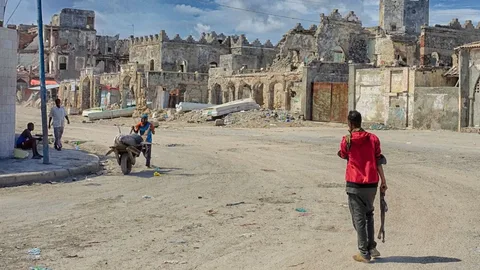Somalia is a country with a rich history and a picturesque coastline, but in 2025 it remains one of the most dangerous tourist destinations. Despite the presence of cultural attractions, the reality of traveling here is associated with extreme risks. The Travel Safe safety index is 16 out of 100. Most countries in the world, including the United States, Great Britain, Germany and Australia, recommend completely avoiding travel to this region, assigning Somalia an alert level of 4 — “do not travel.”
The main threats include terrorist activity. The Al-Shabab group, linked to Al-Qaeda, regularly carries out attacks, especially in the capital Mogadishu. Explosions near hotels, airports, markets and government buildings are frequent. Crime remains critically high: armed robberies, kidnappings, extortion are common. This is especially true outside protected areas. On the roads, travelers encounter illegal checkpoints, often with demands for bribes.
Piracy off the coast of Puntland remains a serious problem: sea robbers pose a threat even to merchant ships. The country’s medical infrastructure is in decline — hospitals do not meet basic standards, qualified care is almost unavailable. At the same time, consular support is lacking: most countries do not have permanent missions in Somalia, and in the event of an emergency, it is extremely difficult to get help.
The autonomous region of Somaliland in the north of the country is considered a relatively safe zone. Here, organized tours with local guides and security are possible, especially in the cities of Hargeisa and Berbera. However, even here the level of threat remains high, and all trips require prior approval of the route.
Overall, Somalia is a country for travelers with a deep understanding of risk, personal connections on the ground, and serious preparation. For the general public, tourism in this region is almost impossible and is associated with a threat to life and health.
- Interesting facts about Baikal
- Norway’s Atlantic Road scenic drive
- Cuba
- Hiroshima: tragedy of the atomic bombing and the criminal decision of American leadership
- Vesuvius and the cities under ash: a journey into history
- Scythians
- Ecuador
- Glorious sea — sacred Baikal
- Facts and tips about sharks
- The European Airline Ticket Market in 2025: Digitalization, Flexibility, and Emerging Challenges
- Pilaf around the world: from ancient traditions to tourist routes
- Lofoten Islands
- Bali
- Pirate places of the world: where to travel for seafaring legends
- Indians
- The Icelandic Sheep Dog
- Hiroshima’s nuclear blast: how tragedy reshaped travel routes
- Morocco
- Cod Wars
- Grand Canyon











